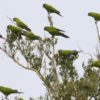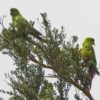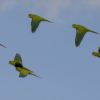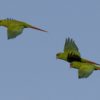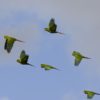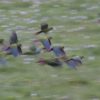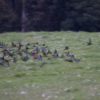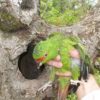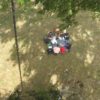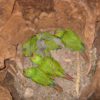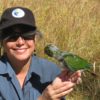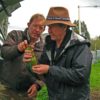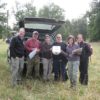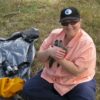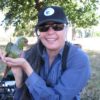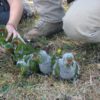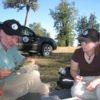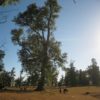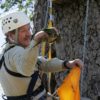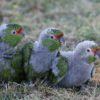Enicognathus leptorhynchus
Southern Chile
The Slender-billed Conure, Enicognathus leptorhynchus, is endemic to southern Chile and one of the most southerly occurring of all parrot species. Detailed scientific data on the basic biology and ecology of the species are virtually nonexistent.
The Project’s lead investigators are Dr. Jaime Jimenez, Ph.D. and Ana Bertoldi of the Universidad de Los Lagos,Osorno, Chile. The Project advisor is Dr. Thomas White, Ph.D. of the USFWS Puerto Rican Parrot Project.
The major goal of the Slender-billed Conure Project is to acquire basic ecological data on the SBP. Such data include nest site selection and nesting behavior, specific data on reproductive chronology and productivity, size of flocks, distribution, abundance and movements in the region, relationship to landscape variables, and habitat used for foraging and other activities. Comparisons between these landscapes will provide information that will allow managers and government authorities to target specific areas for conservation and to quantify the current impacts of agricultural practices on the ecology of this species.
With most parrots, it is usually only when a species has become critically endangered that notice and actions are taken to avert extinction or further decline. Unfortunately, if such actions are taken too late, the necessary conservation measures will have become extremely costly in terms of the human and financial resources needed to overcome the daunting ecological and sociological challenges necessary for recovery efforts. The long range goal of the project is to take a more prudent and proactive approach with the SBP to insure that the species does not become a future “crisis case” requiring drastic and costly measures to assure its survival.
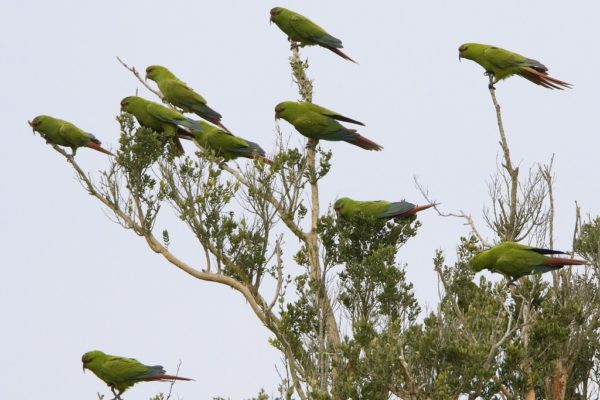 A flock of Slender-billed Conures point their beaks into the prevailing wind. Osorno, Chile. Photo by M. Stafford
A flock of Slender-billed Conures point their beaks into the prevailing wind. Osorno, Chile. Photo by M. Stafford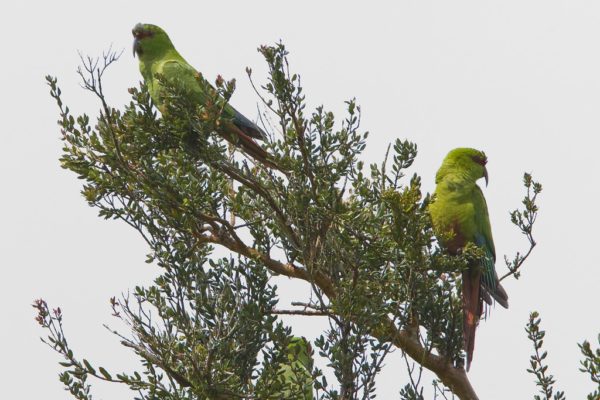 A pair of Slender-billed Conures play sentinel to guard as the rest of their flock forages on the ground. Osorno, Chile. Photo by M. Stafford
A pair of Slender-billed Conures play sentinel to guard as the rest of their flock forages on the ground. Osorno, Chile. Photo by M. Stafford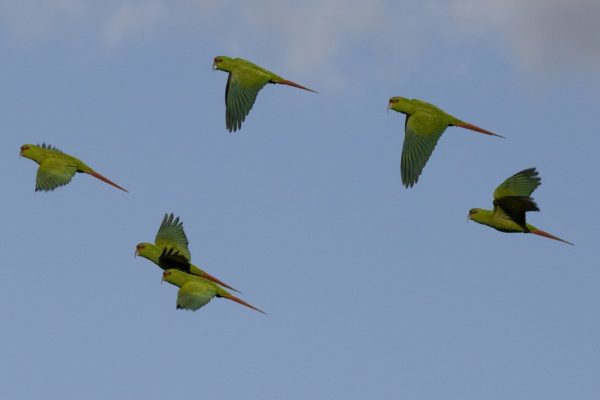 A flock Slender-billed Conures flying between feeding sites. Osorno, Chile. Photo by M. Stafford
A flock Slender-billed Conures flying between feeding sites. Osorno, Chile. Photo by M. Stafford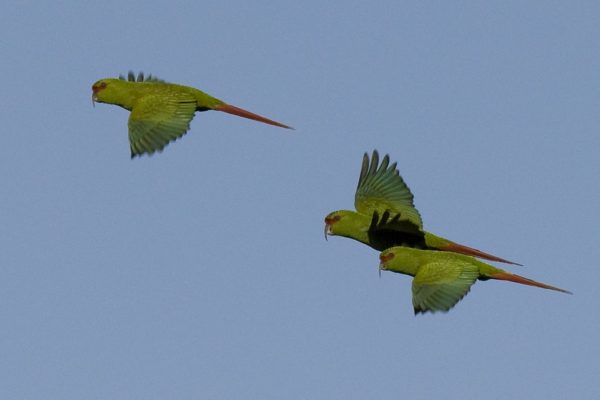 A flock Slender-billed Conures flying between feeding sites. Osorno, Chile. Photo by M. Stafford
A flock Slender-billed Conures flying between feeding sites. Osorno, Chile. Photo by M. Stafford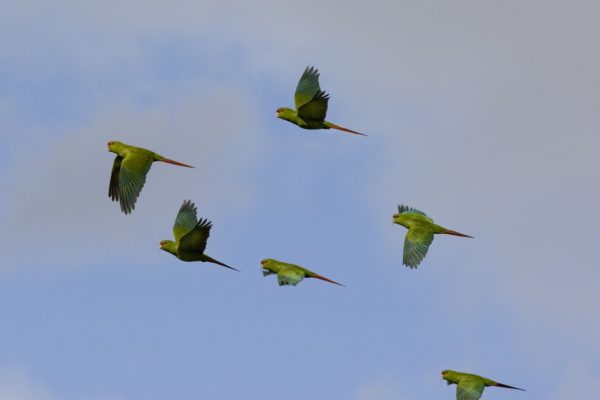
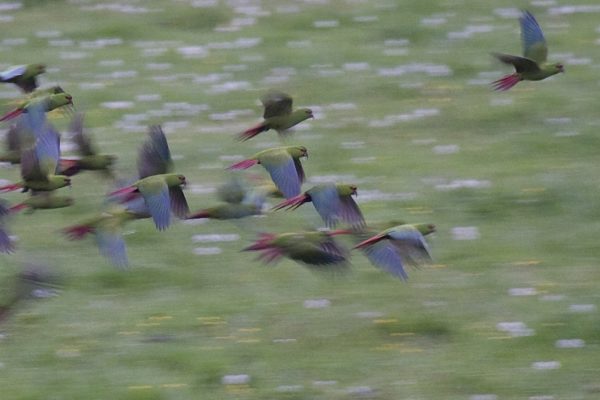 A flock Slender-billed Conures bolt from their feeding site on the ground . Osorno, Chile. Photo by M. Stafford
A flock Slender-billed Conures bolt from their feeding site on the ground . Osorno, Chile. Photo by M. Stafford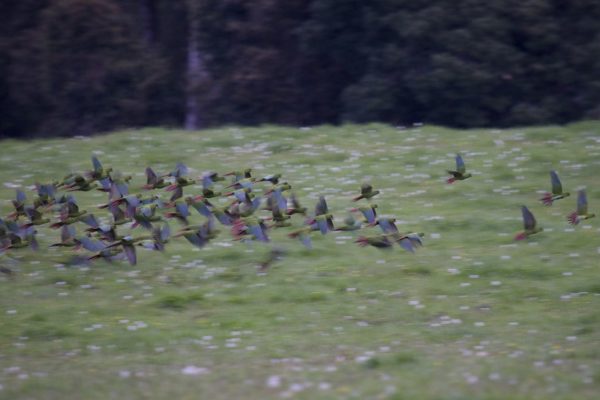 A flock Slender-billed Conures lift off from their feeding site on the ground . Osorno, Chile. Photo by M. Stafford
A flock Slender-billed Conures lift off from their feeding site on the ground . Osorno, Chile. Photo by M. Stafford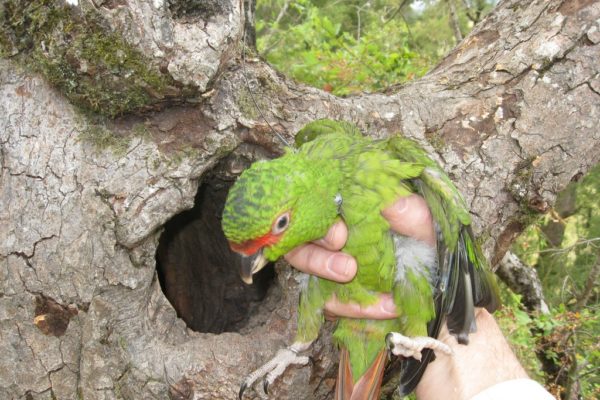 A Slender-billed Conure chick is returned by Mark Stafford to its nest high in a Nothofagus tree (southern beech) after receiving a radio collar. Once the chick fledges he is track by telemetry. His data helps establish his range and use of the habitat. Photo by M. Stafford
A Slender-billed Conure chick is returned by Mark Stafford to its nest high in a Nothofagus tree (southern beech) after receiving a radio collar. Once the chick fledges he is track by telemetry. His data helps establish his range and use of the habitat. Photo by M. Stafford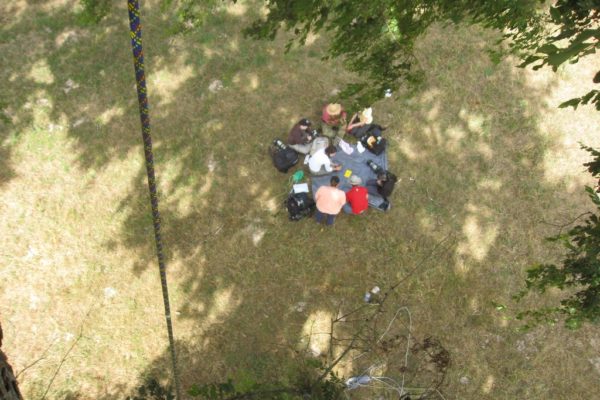 A view of the field team from the top of a Nothofagus tree (southern beech). The team is performing measurements, weights and blood draw on the chick prior to its return to the nest. Photo by M. Stafford
A view of the field team from the top of a Nothofagus tree (southern beech). The team is performing measurements, weights and blood draw on the chick prior to its return to the nest. Photo by M. Stafford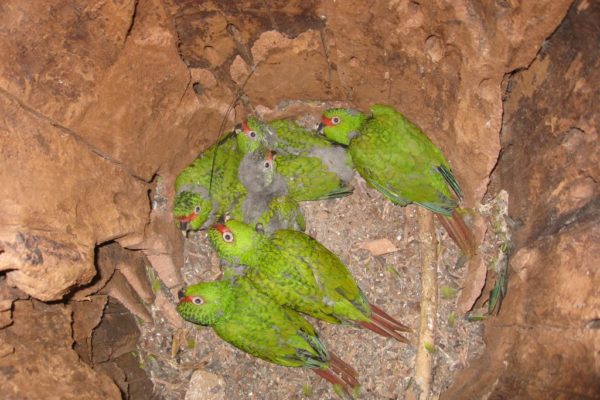 A Slender-billed Conure nest with one sibling showing off its new radio collar. One the chicks fledge the radio collared chick will be followed and tracked via telemetry. The data recorded by the fledgling helps establish his/her range and use of the habitat. Photo by M. Stafford
A Slender-billed Conure nest with one sibling showing off its new radio collar. One the chicks fledge the radio collared chick will be followed and tracked via telemetry. The data recorded by the fledgling helps establish his/her range and use of the habitat. Photo by M. Stafford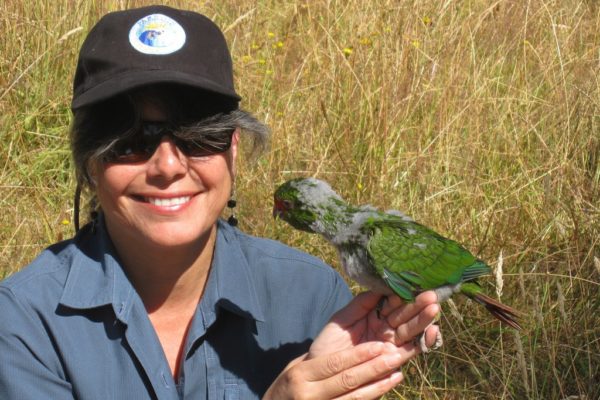 Marie Stafford of Parrots International preparing to return a Slender-billed Conure chick to its nest after carefully fitting it with a radio collar. Photo by M. Stafford
Marie Stafford of Parrots International preparing to return a Slender-billed Conure chick to its nest after carefully fitting it with a radio collar. Photo by M. Stafford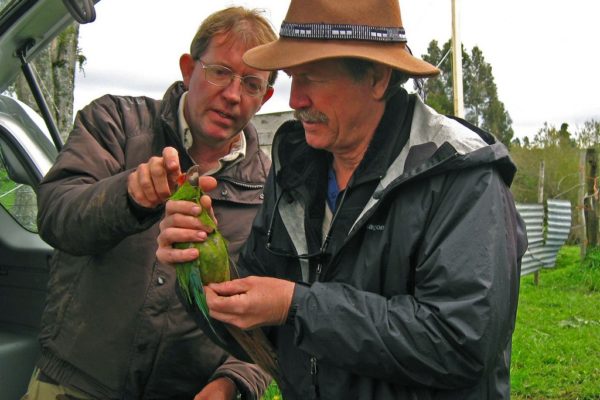 Dr. Tom White (USFWS) and Dr. Mark Stafford (Parrots International) placing the first radio collar ever placed for scientific research on a wild Slender-billed Conure. Osorno, Chile. Photo by M. Stafford
Dr. Tom White (USFWS) and Dr. Mark Stafford (Parrots International) placing the first radio collar ever placed for scientific research on a wild Slender-billed Conure. Osorno, Chile. Photo by M. Stafford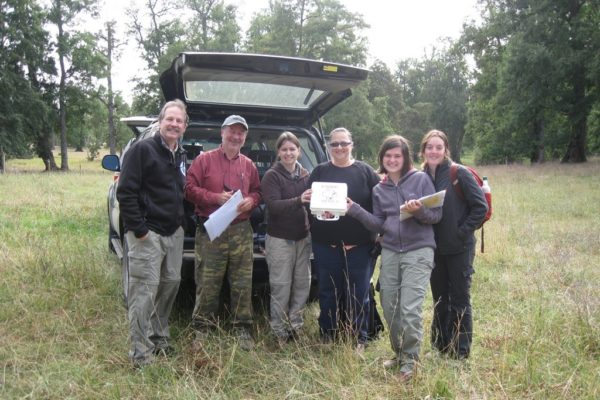 The Parrots International volunteers assisting with the Slender-billed Conure Project. Left to right: Mark Stafford, Jaime Jimenez (project director), Nathalie Lemieux, Suzan Payne, Ana Bertoldi (lead investigator), and her assistant. Ana and Nathalie are holding the Parrot First Aid Kit they assembled and donated to the project. Osorno, Chile. Photo by M. Stafford
The Parrots International volunteers assisting with the Slender-billed Conure Project. Left to right: Mark Stafford, Jaime Jimenez (project director), Nathalie Lemieux, Suzan Payne, Ana Bertoldi (lead investigator), and her assistant. Ana and Nathalie are holding the Parrot First Aid Kit they assembled and donated to the project. Osorno, Chile. Photo by M. Stafford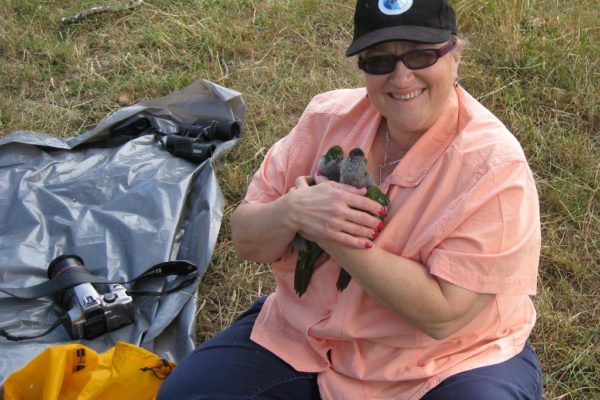 Parrots International volunteer Suzan Payne holding chicks while their sibling is being weighed, measured, a blood sample taken, and radio collar fitted. All the chicks are then returned to their nest high in a Nothofagus tree. Osorno, Chile. Photo by M. Stafford
Parrots International volunteer Suzan Payne holding chicks while their sibling is being weighed, measured, a blood sample taken, and radio collar fitted. All the chicks are then returned to their nest high in a Nothofagus tree. Osorno, Chile. Photo by M. Stafford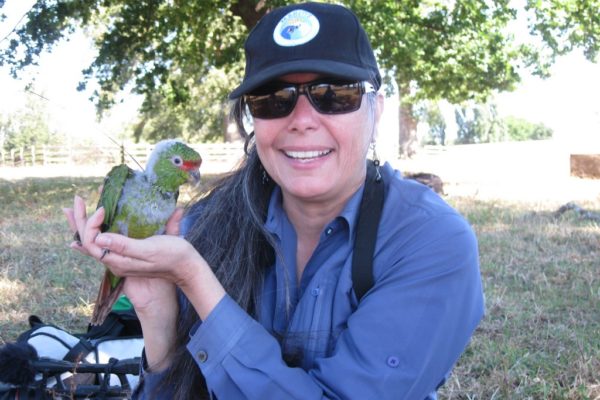 Marie Stafford of Parrots International holding a Slender-billed Conure chick after carefully fitting with a radio collar. Osorno, Chile. Photo by M. Stafford
Marie Stafford of Parrots International holding a Slender-billed Conure chick after carefully fitting with a radio collar. Osorno, Chile. Photo by M. Stafford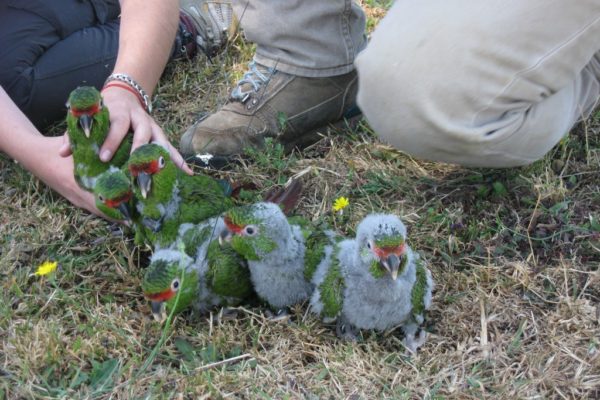 Six siblings from one nest. The two largest chicks have just been fitted with radio collars. Osorno, Chile. Photo by M. Stafford
Six siblings from one nest. The two largest chicks have just been fitted with radio collars. Osorno, Chile. Photo by M. Stafford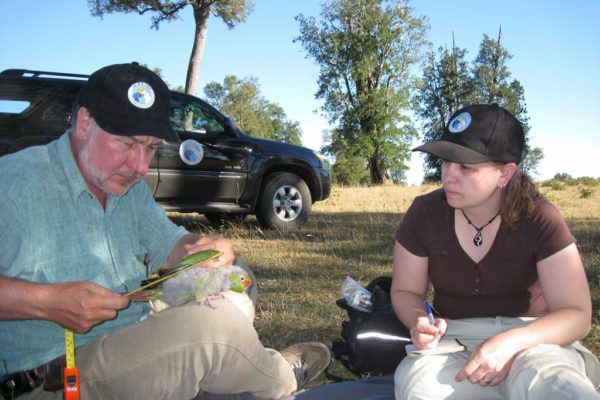 Jaime Jimenez (project director) and Nathalie Lemieux (Parrots International volunteer) perform a field measurement of a Slender-billed conure chick. Note the Parrots International vehicle in the background. Osorno, Chile. Photo by M. Stafford
Jaime Jimenez (project director) and Nathalie Lemieux (Parrots International volunteer) perform a field measurement of a Slender-billed conure chick. Note the Parrots International vehicle in the background. Osorno, Chile. Photo by M. Stafford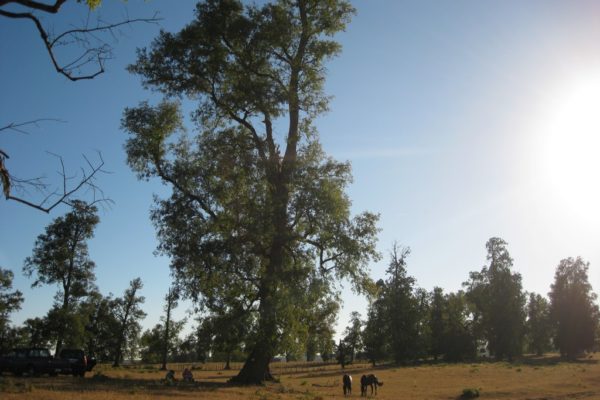 Dr. Mark Stafford (Parrots International) 17 meters high in a Nothofagus tree at the nest cavity entrance of a Slender-billed Conure. The chicks are lowered to the ground for scientific measurement and radio collar placement. Osorno, Chile. Photo by M. Stafford
Dr. Mark Stafford (Parrots International) 17 meters high in a Nothofagus tree at the nest cavity entrance of a Slender-billed Conure. The chicks are lowered to the ground for scientific measurement and radio collar placement. Osorno, Chile. Photo by M. Stafford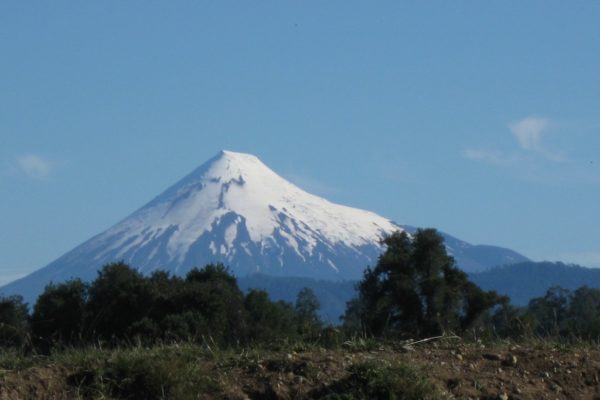 The amazing view from the Slender-billed study site. Osorno, Chile. Photo by M. Stafford
The amazing view from the Slender-billed study site. Osorno, Chile. Photo by M. Stafford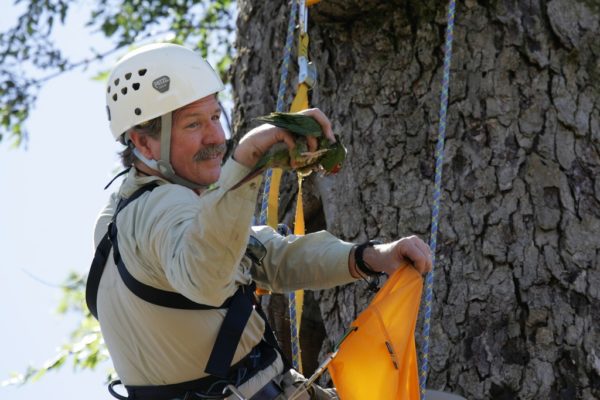 Dr. Mark Stafford (Parrots International) prepares to lower a Slender-billed conure chick from its nest cavity to the ground. Their the field team performs scientific measurement and places a radio collar before sending the chick back up to its nest. Osorno, Chile. Photo by M. Stafford
Dr. Mark Stafford (Parrots International) prepares to lower a Slender-billed conure chick from its nest cavity to the ground. Their the field team performs scientific measurement and places a radio collar before sending the chick back up to its nest. Osorno, Chile. Photo by M. Stafford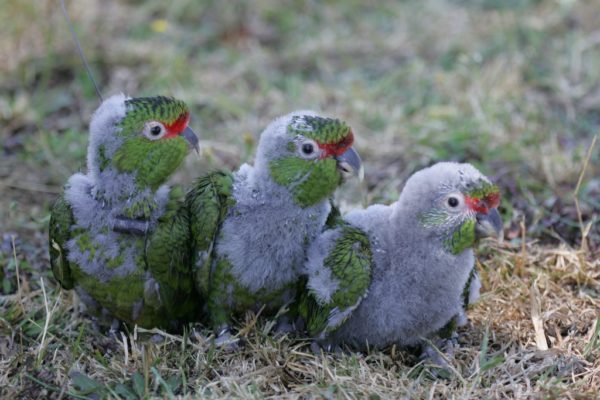 The "Three Amigos" prior to return by Parrots International volunteers to their nest. Osorno, Chile. Photo by M. Stafford
The "Three Amigos" prior to return by Parrots International volunteers to their nest. Osorno, Chile. Photo by M. Stafford





